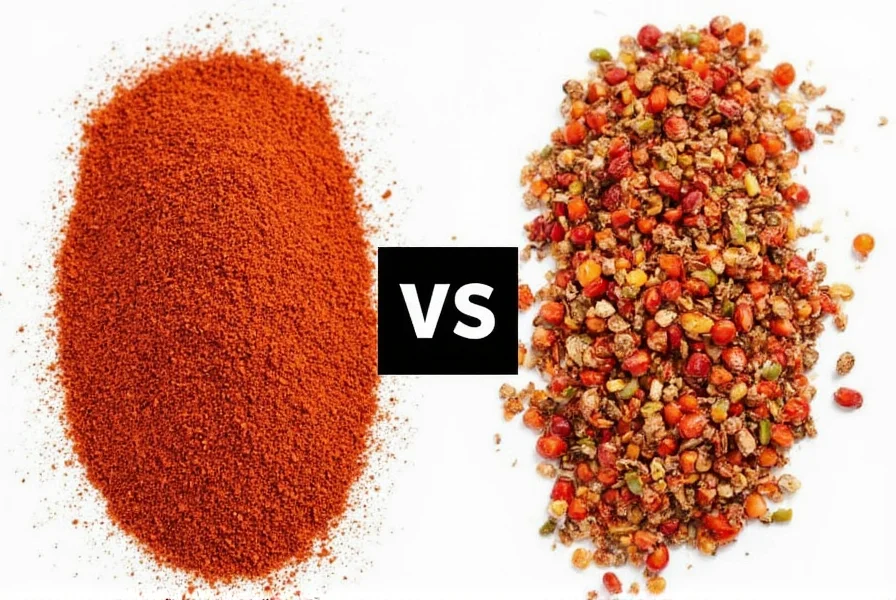Many home cooks find themselves staring at spice aisle labels, wondering if crushed red pepper and chili flakes are truly different ingredients or just marketing variations. This confusion stems from inconsistent labeling practices across brands and regions, despite both products serving the same culinary purpose: adding heat and flavor to dishes.
What Exactly Are Crushed Red Pepper and Chili Flakes?
Crushed red pepper and chili flakes refer to the same category of spice—dried chili peppers that have been broken into small flakes. These products typically contain a blend of辣椒 varieties including cayenne, ancho, and other red chili peppers. The confusion arises because different manufacturers use different names for identical products.
Major spice companies like McCormick, Simply Organic, and Frontier Co-op sell what is essentially the same product under both "crushed red pepper" and "chili flakes" labels depending on regional preferences. In some areas, "chili flakes" is the preferred term, while in others, "crushed red pepper" dominates shelf labels.
Composition and Ingredients Comparison
When examining ingredient lists, both products typically contain:
| Product Type | Typical Ingredients | Common Additives |
|---|---|---|
| Crushed Red Pepper | Dried red chili peppers (cayenne, ancho) | Silicon dioxide (anti-caking agent) |
| Chili Flakes | Dried red chili peppers (similar varieties) | Silicon dioxide (anti-caking agent) |
The primary difference between crushed red pepper vs chili flakes lies not in their composition but in regional naming conventions. Some specialty brands might use slightly different pepper blends, but the fundamental product remains the same across most mainstream grocery store offerings.
Texture and Physical Characteristics
Both products feature irregularly shaped flakes ranging from fine particles to larger, recognizable pepper pieces. The texture variation depends more on the specific brand's processing method than on whether it's labeled as crushed red pepper or chili flakes.
When comparing crushed red pepper ingredients across brands, you'll notice:
- Consistency ranges from coarse to fine depending on manufacturer
- Color varies from bright red to deeper burgundy based on pepper maturity
- Some brands include seeds (adding heat), while others remove them

Flavor Profile and Heat Level Analysis
Understanding the difference between crushed red pepper and chili flakes requires examining their heat and flavor characteristics. Both products typically register between 30,000-50,000 Scoville Heat Units (SHU), placing them in the medium-hot range.
The flavor profile includes:
- Earthy, slightly smoky base notes
- Bright, tangy acidity
- Gradual heat build-up rather than immediate burn
- Subtle fruitiness depending on pepper varieties used
When considering crushed red pepper vs red pepper flakes nutrition, both offer identical nutritional profiles—virtually zero calories, no fat, and small amounts of vitamin A and C. The nutritional difference between the two is negligible since they're the same product.
Culinary Applications and Usage Tips
Professional chefs and home cooks use these spices interchangeably in most applications. Understanding when to use crushed red pepper versus chili flakes comes down to personal preference rather than technical differences.
Best practices for using either product include:
- Add during cooking for integrated heat or at the end for brighter flavor
- Toast lightly in oil to enhance flavor complexity
- Pair with acidic ingredients like tomatoes or vinegar to balance heat
- Use in Italian, Mexican, and Asian cuisines where red pepper heat is desired

Substitution Guidance for Home Cooks
When considering can I substitute crushed red pepper for chili flakes, the answer is almost always yes. They can be used interchangeably in a 1:1 ratio in virtually all recipes.
For those seeking alternatives to either product, consider:
- Cayenne pepper (use 1/2 amount as it's significantly hotter)
- Hot paprika (milder option with similar color)
- Crushed Aleppo pepper (more complex, fruitier flavor)
- Chipotle powder (smokier profile with different heat characteristics)
When substituting, remember that the best substitute for chili flakes depends on whether you prioritize matching the heat level, flavor profile, or visual appearance in your dish.
Storage Recommendations for Maximum Freshness
Both products should be stored identically to preserve flavor and heat:
- Keep in airtight containers away from light and heat
- Store in a cool, dark pantry (not above the stove)
- Use within 6-12 months for optimal flavor (though safe indefinitely)
- Freeze for long-term storage (up to 2 years)
Signs of degraded quality include faded color, diminished aroma, and reduced heat intensity—indicating it's time to replace your supply regardless of whether it's labeled as crushed red pepper or chili flakes.
Common Misconceptions Clarified
Several myths persist about the difference between crushed red pepper and chili flakes:
- Myth: Crushed red pepper contains only cayenne peppers
Fact: Most blends include multiple chili varieties for balanced flavor - Myth: Chili flakes are always hotter than crushed red pepper
Fact: Heat level depends on specific pepper blend, not the name - Myth: One is significantly healthier than the other
Fact: Nutritional profiles are identical since they're the same product
Practical Buying Guide
When selecting either product, focus on these quality indicators rather than the name:
- Bright red color (dull brown indicates age)
- Strong, pleasant aroma when opening the container
- Visible variation in flake sizes (indicates whole-pepper processing)
- Minimal fine powder at the bottom of the container
Price differences between crushed red pepper vs chili flakes typically reflect brand reputation rather than quality differences. Specialty blends with specific pepper varieties will cost more but offer distinctive flavor profiles.











 浙公网安备
33010002000092号
浙公网安备
33010002000092号 浙B2-20120091-4
浙B2-20120091-4